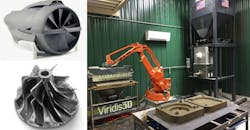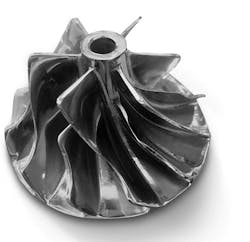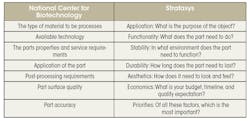What’s the Difference Between Metal 3D Printing Processes?
Materials and processes is often a freshman level course in college. With the expansion of new technology, some engineers might find a refresher course that includes additive manufacturing, also called 3D printing, valuable. It can be difficult when looking for new solutions and become inundated with new technology.
This article will mention some of the difference between metal 3D printing processes and selection criteria to help understand this technology better. This does not cover all the processes. There is a lot of great research happening in this area, but the following introduces some of the more common processes.
Electron Beam Melting (EBM) is similar to SLM, but an electron beam is used instead of a laser. Bed temperatures are higher (~870 K), and the EBM environment is performed in a vacuum rather than the Inert gas used in SLM. One drawback to EBM is that is involves more process parameters that means the process will take more expertise and time to optimize. The NCBI paper outline the following parameters involved in the EBM process:
- Beam power
- Beam scanning velocity
- Beam focus
- Beam diameter
- Beam line spacing
- Plate temperature
- Pre-heat temperature (including the repetitions, speed, and power of the beam)
- Contour strategies
- Scan strategy
The complexity of the process limits EBM materials. EBM has been known to use Ti grade 2, Ti6Al4V, Inconel 718, and CoCrMo. SLM cannot produce many brittle materials such as intermetallics because its high cooling rate will cause internal stresses. Longer cooling times can be both a pro and a con for EBM.
Binder jetting (BDJ) is a powder bed process but instead of lasers or electron beams, a binder agent holds the powder together. A (green) part is produced faster than any of the other powder bed processes, but this is only the first step. Post-processing—such as curing, de-powdering, sintering, infiltration, annealing, and finishing the part—will often take more time than creating the first green part.
Materials
Soft materials. There are design requirements that may lean towards a type of material. From the previous example, binder jetting (BDJ), selective laser melting (SLM), and EBM are all competitive when considering metals/composites. However, EBM temperatures can exceed 870 K and are a concern if a material has a low boiling point, such as Al/Mg/Zn.
This table shows the mechanical property difference of Ti6Al4V when processed with EBM and SLM. SLM’s high cooling creates a better martensitic structure that increases the strength and brittleness of the material.
When considering cooling temperature, it should be noted the powder bed will need to cool before parts can be removed. Higher temperatures will increase the time between printing and removal. In the case of EBM, a powder bed may need to sit overnight. This time slows production and can increase part cost.
Selection Criteria
There are several things to consider when selecting the right process and material. The NCBI and Stratasys both have seven selection criteria, but they are not entirely the same. Stratasys includes polymer 3D printing into its consideration in Identifying the Best 3D-Printing Process for Your Applications, from which this list was compiled.
It can be hard to find good information on 3D printing, as internet searches tend to be crowded with the hype surrounding the processes. In general, Protolabs, Stratasys, 3D Hubs, and Xometry (and of course, Machine Design) are good sources for ungated content.
I’ve also found great technical papers. You can use Google Scholar to search exclusively for technical journals and scholarly articles. They often want you to pay to access them, but there is a way to get around this. You can often read the abstract, and maybe a page or two to determine if it’s a paper you want to read, or the one that might answer your question. Then look for the authors and do an internet search for their contact information.
I’ve been surprised by the authors I was able to find, and if I can find them they normally respond with a full copy of their paper. Most scholarly journals that charge keep 100% of the money, so the professor isn’t losing money sending a copy to you. They might also have some additional insight to any questions you have.
If you have any comments or questions, feel free to reach out to me at [email protected].





